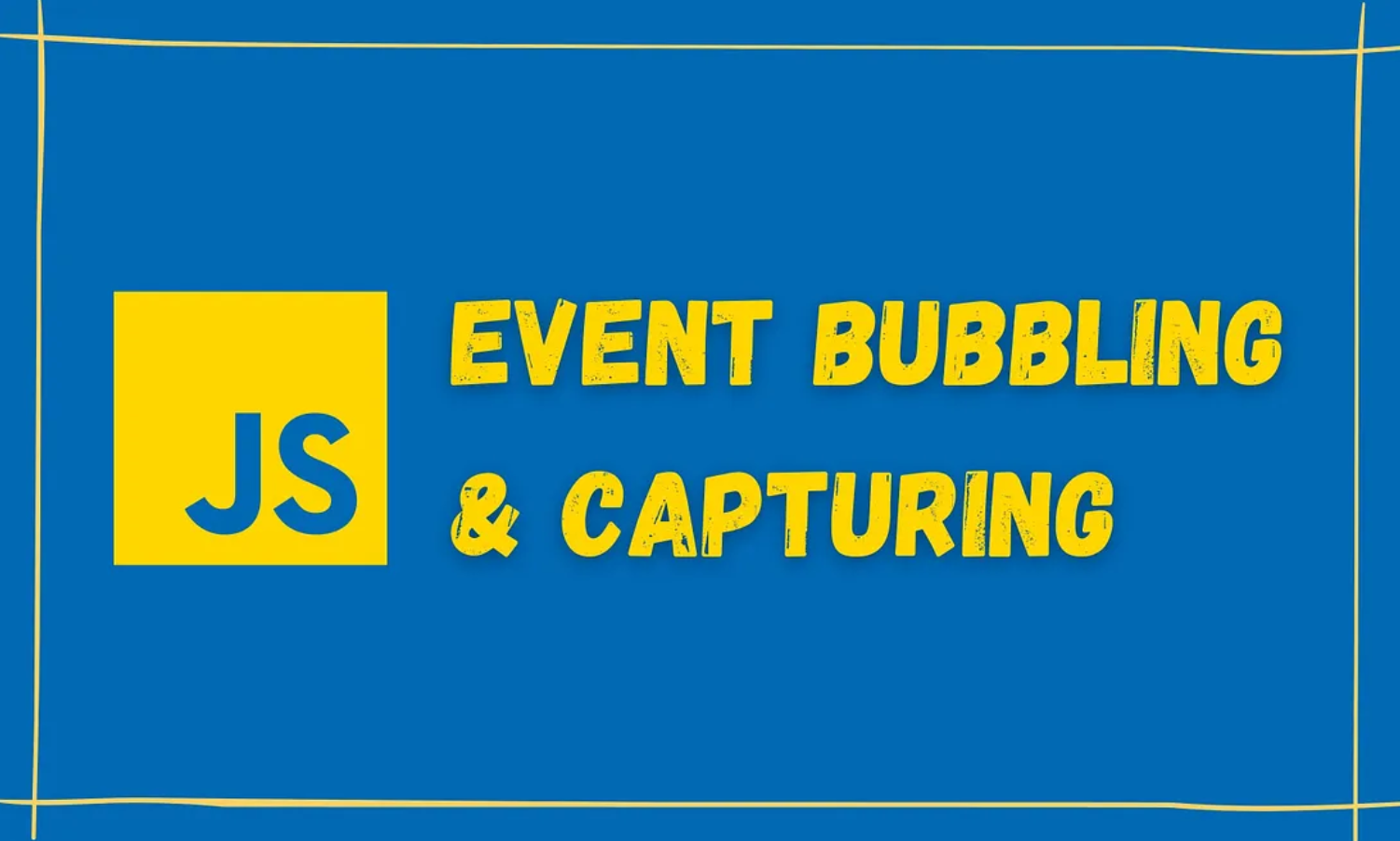Understanding Event Propagation in JavaScript
 Bhavesh Jadhav
Bhavesh Jadhav
In JavaScript, events like clicks don't just stay where they happen. They can move through different parts of your webpage, which is known as event propagation. Let's explore what this means, how it works, and how you can control it using event bubbling and event capturing.
What is Event Propagation?
Event propagation describes how events move through the DOM (Document Object Model) when they are triggered. There are two main ways this can happen:
1. Event Bubbling
Direction: Bottom to Top
Explanation: The event starts at the element where it was triggered and then moves up to its parent elements.
Example: If you click on a button inside a
div, the event first triggers on the button, then on thediv, and finally on thebody.
2. Event Capturing
Direction: Top to Bottom
Explanation: The event starts from the root of the DOM (like the
bodyorhtmltag) and travels down to the target element.Example: The event first triggers on the
body, then thediv, and finally on the button.
Default Behavior in Browsers
In most browsers, event bubbling is the default behavior, meaning events move from the target element up to its parents. However, there are cases where you might want to use event capturing instead. You can control which one is used by specifying true or false when you add an event listener:
false(default): Uses event bubbling (Bottom to Top).true: Uses event capturing (Top to Bottom).
Controlling Event Propagation
You can control how events propagate using two key methods:
e.stopPropagation(): Stops the event from moving to other elements.e.preventDefault(): Stops the browser's default action, like following a link or submitting a form.
Example 1: Preventing Event Bubbling
Here's how you can stop event bubbling:
<!DOCTYPE html>
<html lang="en">
<head>
<meta charset="UTF-8">
<meta name="viewport" content="width=device-width, initial-scale=1.0">
<title>Event Propagation Example</title>
</head>
<body>
<ul>
<li id="man">Man</li>
<li id="woman">Woman</li>
<li id="google"><a href="https://www.google.com">Google</a></li>
</ul>
<script>
document.getElementById('man').addEventListener('click', (e) => {
e.stopPropagation(); // Stops the event from bubbling up
alert('Man was clicked');
}, false); // false indicates event bubbling (default)
</script>
</body>
</html>
In this example, when you click on "Man," an alert shows up, and the event stops there. It doesn't trigger any event listeners on parent elements like ul or body.
Example 2: Using Event Capturing
Now, let’s see how event capturing works by setting the third argument to true:
<!DOCTYPE html>
<html lang="en">
<head>
<meta charset="UTF-8">
<meta name="viewport" content="width=device-width, initial-scale=1.0">
<title>Event Propagation Example</title>
</head>
<body>
<ul>
<li id="dog">Dog</li>
<li id="cat">Cat</li>
<li id="lion">Lion</li>
</ul>
<script>
// Event listener on the 'ul' element using capturing (top to bottom)
document.querySelector('ul').addEventListener('click', (e) => {
alert('Clicked on the UL element');
//e.stopPropagation(); // Stops further event capturing
console.log('UL element was clicked');
},true); // 'true' enables capturing (top to bottom)
// Event listener on the 'dog' element using bubbling (default, bottom to top)
document.getElementById('dog').addEventListener('click', (e) => {
alert('Dog was clicked');
console.log('Dog element was clicked');
// e.stopPropagation(); // Stops further event bubbling
}); // 'false' enables bubbling (bottom to top)
</script>
</body>
</html>
In this example:
Clicking on "Dog" first triggers the
ulevent listener (becausetrueis set, enabling event capturing), showing the alert "UL was clicked during capturing phase."After that, the event triggers the "Dog" event listener, showing the alert "Dog was clicked."
Example 3: Preventing Default Browser Behavior
Here’s how you can prevent a link from navigating away:
<!DOCTYPE html>
<html lang="en">
<head>
<meta charset="UTF-8">
<meta name="viewport" content="width=device-width, initial-scale=1.0">
<title>Prevent Default Behavior</title>
</head>
<body>
<ul>
<li id="google"><a href="https://www.google.com">Google</a></li>
</ul>
<script>
document.getElementById('google').addEventListener('click', function(e) {
e.preventDefault(); // Stops the browser from navigating to the URL
alert('Google link clicked');
e.stopPropagation(); // Stops the event from bubbling up
});
</script>
</body>
</html>
When you click on the "Google" link, instead of navigating to Google, it shows an alert. This is done using e.preventDefault(). We also use e.stopPropagation() to stop the event from affecting other elements.
Example 4: Removing List Items Dynamically
Here's an example of how to remove items from a list when they are clicked:
<!DOCTYPE html>
<html lang="en">
<head>
<meta charset="UTF-8">
<meta name="viewport" content="width=device-width, initial-scale=1.0">
<title>Remove List Items</title>
</head>
<body>
<ul>
<li id="dog">Dog</li>
<li id="cat">Cat</li>
<li id="lion">Lion</li>
<li id="goat">Goat</li>
<li id="buffalo">Buffalo</li>
<li id="man">Man</li>
<li id="woman">Woman</li>
<li id="boy">Boy</li>
<li id="girl">Girl</li>
<li id="guardian">Guardian</li>
<li id="google"><a href="https://www.google.com">Google</a></li>
</ul>
<script>
const ul = document.querySelector('ul');
ul.addEventListener('click', function(e){
console.log(e.target.tagName);
if(e.target.tagName == 'LI'){
e.target.remove(); // Removes the clicked list item
}
});
</script>
</body>
</html>
In this example, when you click on any item in the list, that item is removed from the page.
Conclusion
Understanding event propagation helps you manage how events behave in your web applications. Whether you want to stop an event from going up the DOM or prevent the browser's default actions, using methods like e.stopPropagation() and e.preventDefault() will give you greater control over your events.
Subscribe to my newsletter
Read articles from Bhavesh Jadhav directly inside your inbox. Subscribe to the newsletter, and don't miss out.
Written by

Bhavesh Jadhav
Bhavesh Jadhav
I am a passionate web developer from India, currently pursuing an MCA from Government College of Engineering, Aurangabad. With a strong foundation in HTML, CSS, JavaScript, and expertise in frameworks like React and Node.js, I create dynamic and responsive web applications. My skill set extends to backend development with PHP, MySQL, and MongoDB. I also have experience with AJAX, jQuery, and I am proficient in Python and Java. As an AI enthusiast, I enjoy leveraging AI tools and LLMs to enhance my projects. Eager to expand my horizons, I am delving into DevOps to optimize development workflows and improve deployment processes. Always keen to learn and adapt, I strive to integrate cutting-edge technologies into my work. Let's connect and explore the world of technology together!